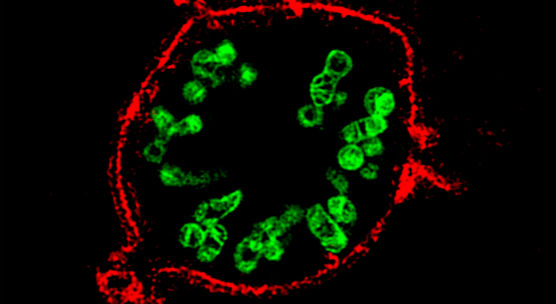Why are our cells the size they are?
Published On Sun 9 Oct 2016 by Roddy Isles

New research from the University of Dundee has discovered that cells of average size are the Olympic athletes of the cellular world, performing better than those which are too big or two small.
When cells and tissue are observed under the microscope, the size of the cells is one of the most obvious features. However, while cells are small in general, cell size varies from one cell type to another - a muscle cell for example is much bigger than a white blood cell.
The research by the team in the School of Life Sciences at Dundee now sheds light on the question of why animal cells are of certain size.
It has been recognised for more than one hundred years that metabolic activity declines with increasing organismal size, a process called metabolic allometry. For example, two smaller dogs will consume more food (energy) than one bigger dog of similar mass.
In a new study, published in the journal Developmental Cell, the Dundee researchers studied metabolic allometry at the cellular level, focusing on mitochondria, the `power generators’ of the cell which are involved in producing energy and cellular building blocks necessary for growth.
Dr Teemu Miettinen, one of the research team, said, “Mitochondria are key organelles setting the overall metabolic activity of cells. What we find is that there is a big difference between the amount of mitochondria and how active they are.
“While the mitochondrial amount increases with cell size, as was expected, there is a decline in mitochondrial activity with increasing cell size. This appears to limit cells from growing too large.
“It appears there is a substantial benefit for cells from growing sufficiently but not too large. The mitochondria in intermediate sized cells are more active, helping cells to perform better. This provides cells of intermediate size a `fitness advantage’. This fitness advantage is probably best illustrated by comparing cells to athletes. Starved or too fat athletes do not perform optimally in sports. The same applies to cells, where those of average size are the peak, Olympic-level performers.”
The findings suggest that the maintenance of cell size within certain limits may be important for the survival and reproductive potential of cells and organisms. Cells need to be able to actively adjust their size to maintain their optimal cellular function to maximise the success of the whole organism.
Another key implication of this work is that problems in controlling growth and cell size may directly relate to the development of metabolic disease. Cellular ageing, for example, is associated with an increase in cell size and decrease in mitochondrial functionality.
“This work suggests the possibility that loss of cell size control leads to mitochondrial dysfunction, which has been linked to a variety of diseases, including neurodegenerative and metabolic disorders,” said Dr Mikael Bjorklund, another of the research team. “It may be that learning how cells sense their physical dimensions and linking it with their metabolic activity can help us to better understand these conditions.”
* Image shows a single human Jurkat cell stained for mitochondria (green) and plasma membrane (red)
For media enquiries contact:
Roddy Isles
Head of Corporate Communications
University of Dundee
Nethergate, Dundee, DD1 4HN
Tel: +44 (0)1382 384910
Mobile: 07800 581902
Email: r.isles@dundee.ac.uk